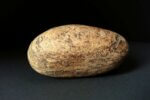I grew up on a “classic American diet” that consisted of peanut butter and jelly on white bread, washed down with large glasses of whole milk. By the time I was in sixth grade at the age of 11 or 12, I was overweight and suffering from the weighty social consequences.
Worst of all, I didn’t understand why. No one ever told me that 60 percent of the calories in the best-selling brands of peanut butter come from fat and something called partially hydrogenated fat or “trans fats.” As a childhood obesity survivor, let me tell you: If your children have a weight problem, give them a new lease on life by cutting out the peanut butter and other margarine and bread products.
Margarine and all margarine-like products managed to rank No. 5 on my “Ten Foods You Should Never Eat” list. I’m sure it wasn’t easy, since there are so many unhealthy contenders out there, but this trans fat family has really earned its bad reputation. How? Basically, the harder the margarine or shortening, the more highly hydrogenated it is. The main problem with the hydrogenation process is that it causes trans fats to act somewhat like saturated fats in terms of their effect on blood cholesterol levels, but with some very dangerous side effects.
The New England Journal of Medicine published a study on the relationship between women’s fat intake and the risk of heart disease. The study, conducted by researchers from Harvard School of Public Health and Brigham and Women’s Hospital over a 14-year period, studied more than 80,000 individuals who had no history of coronary disease, stroke, cancer, high cholesterol or diabetes.
The study found that a “higher dietary intake of saturated fat and trans-unsaturated fat was associated with an increased risk of coronary disease, whereas a higher intake of monounsaturated and polyunsaturated fats was associated with a decreased risk. The researchers concluded that replacing saturated and trans fats with unhydrogenated monounsaturated and polyunsaturated fats is more effective in preventing heart disease in women than reducing overall fat intake.
Another study indicated that trans fats may raise LDL cholesterol to even higher levels and increase the risk of coronary heart disease. At least one study has linked breast cancer risk with high levels of trans-fatty acids in adipose tissue. One thing is clear: Saturated fatty acids (except stearic acid) raise total and LDL cholesterol levels and increase your health risks.
Where Did Margarine Come From?
Margarine was developed in the United States during World War II when there was a shortage of butter. Food processors discovered that they could heat an oil such as vegetable oil, which was readily available and inexpensive, and pump liquid hydrogen through it to form a “hydrogenated” oil that was solid at room temperature. Biochemists call these trans fats because they are in transition. (Some trans fats occur naturally in certain meats and dairy products).
This new product met a temporary need during the war, but manufacturers liked the product because trans-fatty acids like margarine and Crisco have a longer shelf life—a much longer shelf life—than unhydrogenated oils. They felt that the hydrogenation process created a more stable liquid or semi-solid form, which better suited their marketing goals. Some manufacturers claimed their partially hydrogenated vegetable oil shortenings made flakier pie crusts than butter or oils. The partial hydrogenation process increased the stability of oil in the sense that it made it less susceptible to spoiling when exposed to air. The rest is marketing history.
Attractive Alternative
Many people find it very difficult to quit the margarine habit “cold turkey,” so I have found an attractive alternative that lets you enjoy a spread on your bread without too much of a spread around your waist. One of the best alternatives is to use butter with equal parts of cold-pressed virgin olive oil and a little fresh garlic. You will have to keep it refrigerated, of course, but at least you will have a viable alternative to margarine products.
The best choice, of course, is to stop using butter and margarine products altogether, in favor of modest amounts of straight virgin cold-pressed olive oil. Again, if you mix a little bit of garlic in with the oil, your healthy dressing will acquire a delicious flavor that can be basted on whole grain breads and used as a dressing for salads. Remember, if your primary health goal is to lose weight, then you need to stay away from all oils as much as possible.
The preceding is an excerpt from Ted Broer’s book, Maximum Energy. Broer, a university-trained biochemist, exercise physiologist and licensed nutritionist, nearly died of heart disease at the age of 27. He has spent nearly two decades studying the relationships between nutrition, exercise, disease and premature death. Maximum Energy details the top 10 strategies for maximized energy, along with the top 10 foods never to eat.







Leave a Comment
You must be logged in to post a comment.